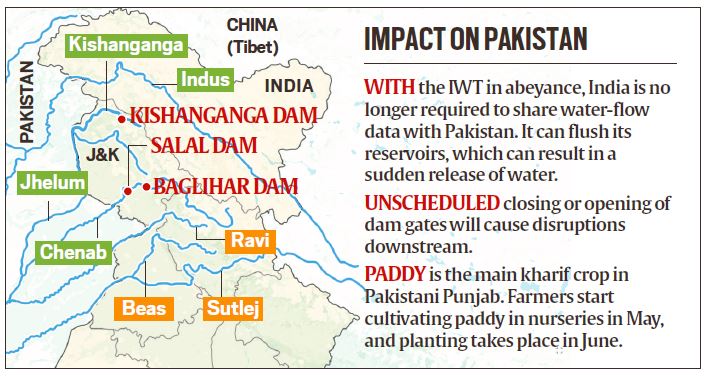However, the river rose to its normal level of 19-20 ft in Akhnoor on Tuesday. Officials at the Salal hydel power project said water was allowed to flow after the reservoirs of the two dams, emptied during a desiltation exercise on Friday and Saturday, were filled.

This came days after India decided to keep the Indus Waters Treaty (IWT) of 1960 in abeyance with “immediate effect”.
While the announcement followed the attack in Pahalgam by Pakistani terrorists, there has long been a feeling in J&K that the IWT prevents the full exploitation of India’s water resources.
In 2002, the Legislative Assembly of the erstwhile J&K state had passed a resolution calling for the termination of the IWT and, in 2011, the National Conference government had appointed a consultant to quantify the loss suffered by J&K on account of the Treaty.
In Pakistan, on the other hand, there has been an enduring narrative that India wants to starve it of the waters of the Indus system by building dams upstream.

Large dams in J&K
The National Register of Large (Specified) Dams lists 15 large (specified) dams in Jammu and Kashmir as of September 2023.
Story continues below this ad
The National Dam Safety Authority (NDSA) defines a large (specified) dam as (i) one that is higher than 15 metres, measured from the lowest part of the general foundation area to the top; or (ii) one that is 10-15 metres in height, and satisfies at least one of five specified criteria relating to the length of the crest, capacity of reservoir, maximum flood discharge, foundation, and design.
Four of the 15 large (specified) dams in J&K are on the Chenab — Salal (rockfill dam), Salal (concrete dam), Baglihar, and Dul. The river, which enters J&K after flowing for 122 km in Himachal Pradesh, drains the eastern section of the southern slopes of the Pir Panjal, the Jammu hills, and the foothills.
IWT and Chenab
The IWT identifies the Chenab as one of the three “Western Rivers” (along with the Indus and Jhelum) which Pakistan controls.
However, India is allowed restricted use of the waters of the three Western Rivers for domestic use, non-consumptive use, agricultural use (as set out in Annexure C of the IWT), and generation of hydro-electric power (Annexure D).
Story continues below this ad
For agriculture, the IWT allows India to withdraw up to 1,000 cusecs between April 15 and October 14, and 350 cusecs (from October 15 to April 14) for Ranbir Canal; and 400 cusecs (April 15-October 14), and 100 cusecs (October 15-April 14) for Pratap Canal.
To generate hydroelectric power, India is allowed to build run-of-the river plants on all the three Western Rivers. A run-of-the-river plant generates power from the natural flow of water. Both Salal and Baglihar on the Chenab are run-of-the river projects.

Baglihar project
With a height of 143 metres, the Baglihar dam in Ramban district has a gross storage capacity of 428.28 million cubic metres (MCM) and live storage capacity of 31.11 MCM.
The dam, which was commissioned in 2009, is operated by the J&K Power Development Corporation. Baglihar Stage-1 has an installed capacity of 450 megawatt.
Salal project
Story continues below this ad
The Salal power project has an installed capacity of 690 MW (Stages I and II of 3 x115 MW each), and the plant was commissioned in stages in 1987, 1993, 1994, and 1995.
With a height of 81.38 meters, Salal (concrete dam) has a gross capacity and live storage capacity of 284.1 MCM and 271.3 MCM respectively. The dam is managed and operated by the NHPC Limited.










































